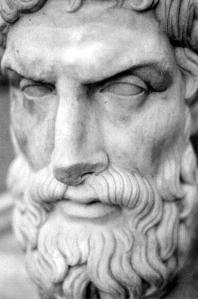Third Century BCE
“Epicurus’s philosophy combines a physics based on an atomistic materialism with a rational hedonistic ethics that emphasizes moderation of desires and cultivation of friendships.”
Summarized by the Roman author Lucretius, who wrote ‘On the Nature of the Universe’ in 55 BCE – “The light and heat of the Sun; these are composed of minute atoms which, when they are shoved off, lose no time in shooting right across the interspace of air in the direction imparted by the shove”. This may be considered as accurate for the time, when most people thought that sight was associated with something reaching out from the eye (EMPEDOCLES) .
Plato wrote of a marriage between the inner light and the outer light.
Euclid worried about the speed with which sight worked. He pointed out that if you close your eyes, then open them again, even the distant stars reappear immediately in your sight, although the influence of sight has had to travel all the way from your eyes to the stars and back again before you could see them.


 NEXT
NEXT

 NEXT
NEXT